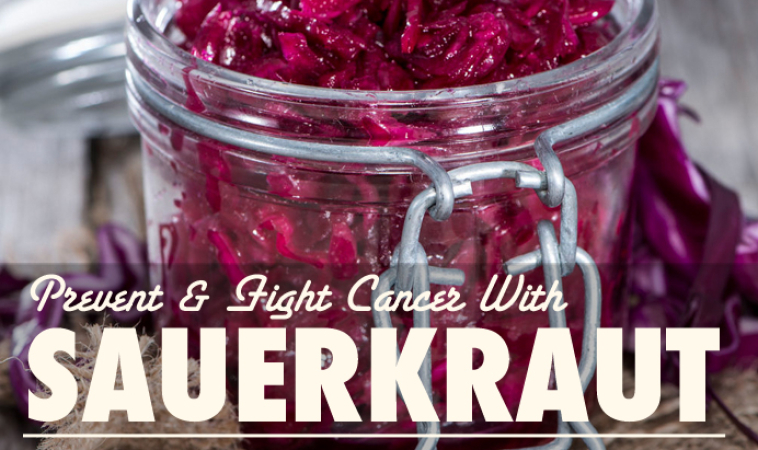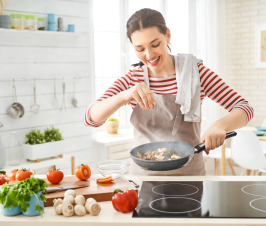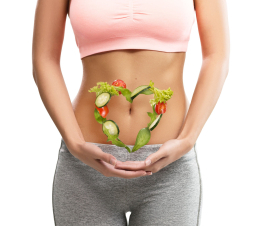Do-it-yourself projects are exhilarating. They offer a sense of accomplishment from completing a task you previously thought only factories, machines or someone else could do. They provide a sense of self-adoration that is both warranted and addictive.
When it comes to making your own food or natural products, such as deodorant, sauerkraut is an excellent candidate. Not only is sauerkraut good for you, it is also delicious, and easy to make.
Why Eat Sauerkraut or Other Fermented Foods?
Fermentation is the process of breaking down an organic substance into simpler versions in the presence of microorganisms. In this case, it is the anaerobic process of converting sugars to lactic acid and carbon dioxide in the presence of bacteria. As a result, new compounds are created with implications for good health:
- Cabbage juice is antimicrobial, found to inhibit e.coli, candida and listeria production.1
The presence of opportunistic organisms in the gut can predispose us to illness. Inhibiting the growth of pathogenic bacteria and yeast allows good bacteria to take up space and utilize resources. Good bacteria such as bifidobacteria, lactobacilli, Bacteroides and clostridia do lots of things for us including production of B12 from meat sources, creating optimal intestinal pH and regulating the immune system.2,3,4
- Fermentation increases antioxidant activity in cabbage
Antioxidants help to scavenge the free radicals that are produced by metabolic activity in the cells. When these free radicals are captured, they are no longer free to damage tissues leading to inflammation. Inflammation is the root cause of the majority of chronic illnesses such as diabetes, arthritis, chronic pain, Crohn’s and Colitis to name a few. Making sure you are reducing your intake of toxins, processed foods and oxidized fats will reduce free radical production and inflammation.5
- Sauerkraut lowers phytic acid content which decreases the availability of zinc, manganese, copper, molybdenum, calcium, magnesium and iron.
Each of these minerals plays an important role in our body such as: immune function, bone density, muscle relaxation and oxygen carrying.6
- Vitamins are formed during the fermentation process: Vitamin B1, B2, tetrahydrofolate (B9), B12 and K.7
B vitamins are ubiquitously required for the biochemical reactions of the body. Their main function is in energy production. B vitamins are water soluble so they deplete easily especially with alcohol use or improper bowel function causing diarrhea. Vitamin K is a fat soluble vitamin acting in our clotting cascade and on bone density. People with higher levels of vitamin K have been shown to have greater bone density.8 Take care of your gut to keep your energy levels up, your wounds clotted and bones strong.
- Cabbage is rich with glutamine, an amino acid that helps heal the enterocyte cells of the gut. Glutamine has been shown to protect against oxidative injury, inflammatory injury and cell death in humans.9 A healthy gut is the seat of the immune system and nutrient absorption. Keep it healthy!
- Sauerkraut prevents and fights cancer
Sauerkraut is chemoprotective and anticarcinogenic. The chemopreventive activity linked to cruciferous vegetables has to do with their ability to modulate the liver detoxification pathways responsible for breaking down estrogen and compounds produced as a result of fermentation. Cruciferous compounds, like ascorbigen produced by fermentation of white cabbage has been shown to be anticarcinogenic against both mammilary and colon tumors in rats.10 Rats treated with sauerkraut juices show an increase in two key enzymes which promote Phase ll detoxification in the liver.11 Additionally, glucosinolates in sauerkraut can modulate the activity of carcinogen-metabolising enzyme systems by activating Phase II detoxification enzymes in the liver.12 The liver’s ability to breakdown estrogen substantially contributes to their carcinogenic effects, particularly for breast cancer. Consumption of isothiocynates, a component of sauerkraut, has been inversely associated to breast cancer risk in premenopausal women.13
The consumption of fermented cabbage has numerous health benefits, so what is fermentation exactly?
 The Process
The Process
Fermentation is a two step process. It starts when the sugar in the cabbage is converted to lactic acid, acetic acid, alcohol and CO2 by the microorganisms, mostly Leuconostoc mesenteroides, found in the cabbage and on its leaves. Carbon dioxide functions to maintain an anaerobic environment necessary for fermentation. The second step occurs when the CO2 reaches a certain level, and the microorganisms in the cabbage are inhibited and replaced by lactobacillus species, which can handle the acidic environment.
The Recipe
Utensils (wash them all with hot soapy and water to give the good bacteria a fighting chance):
- Your hands
- Cutting board
- Large knife
- 1L mason jar
- Wooden spoon
- 1 tbs unrefined Himalayan or sea salt. * I like to use coarse Himalayan salt
- 1 large red or green cabbage
Directions
- Remove 3 or 4 of the outer leaves of the cabbage. Cut into 4 pieces and remove hard core that runs from the bottom, through the centre.
- Slice up the cabbage wedges perpendicular to the core creating thin slices. Place all the cabbage into a bowl.
- Add salt to the cabbage and begin to knead it. This looks like picking handfulls of cabbage up and squishing it through you fingers like a kid with playdough. As you do this, the cabbage will wilt and finally give off juice. This is great! Don’t discard it. Just keep going until all the cabbage is lifeless, devoid of its sulfur taste and sitting in a pool of its own juice.
- Add the cabbage to your mason jar. Packing it in with the spoon so there are no air pockets! Keep packing it in. When you get to the top, place 2 whole leaves from earlier across the top and tuck in the edges. These top leaves are going to keep the little cabbage pieces from floating up to the surface when you add the liquid.
- Add the liquid until the top. Place the lid on and leave in the counter, out of direct sunlight.
*IMPORTANT NOTE! Each day, unscrew the mason jar lids and let the air out. The process of fermentation creates gas and, to avoid explosion (unlikely), open the jars once a day.
After the 3rd day you can start tasting it to see if you like the flavor. When you are happy with it, place it in the fridge to slow the fermentation process. Don’t worry about opening the lids anymore.
Serve: on top of salads, as a side, with all your meals. It’s delicious. Enjoy!
To learn more about cancer prevention, visit thecancersummit.com
 Dr. Ariel Jones is a native of Vancouver BC and a graduate of BINM (2013). Her practice emphasizes removing the physical, mental and spiritual obstacles to cure while implementing a toxin-free lifestyle for raw, radiant health. Ariel has enjoyed living in Victoria, BC during her BSc. in biology and psychology, Calgary AB and Hilo Hawaii for a post-graduate residency focused on raw food diet, detoxification, addictions and cancer therapies.
Dr. Ariel Jones is a native of Vancouver BC and a graduate of BINM (2013). Her practice emphasizes removing the physical, mental and spiritual obstacles to cure while implementing a toxin-free lifestyle for raw, radiant health. Ariel has enjoyed living in Victoria, BC during her BSc. in biology and psychology, Calgary AB and Hilo Hawaii for a post-graduate residency focused on raw food diet, detoxification, addictions and cancer therapies.
References:
- Tolonen, M., S. Rajaniemi, JM Pihlava, T. Johansson, PEJ Saris, and EL Ryhanen. “Formation of Nisin, Plant-derived Biomolecules and Antimicrobial Activity in Starter Culture Fermentations of Sauerkraut.” Formation of Nisin, Plant-derived Biomolecules and Antimicrobial Activity in Starter Culture Fermentations of Sauerkraut. Elsevier, 1 Apr. 2004. Web. 25 July 2015.
- Santos, Filipe, JOse L. Vera, René Van Der Heijden, Graciela Valdez, Willem M. De Vos, Fernando Sesma, and Jeroen Hugenholtz. “F The Complete Coenzyme B12 Biosynthesis Gene Cluster of Lactobacillus Reuteri CRL1098.” Society for General Microbiology Journals. Society for General Microbiology Journals, 01 Jan. 2008. Web. 25 July 2015.
- Yamano, Toshihiko, Hisakazu Iino, Mamiko Takada, Stephanie Blum, Florence Rochat, and Yoichi Fukushima. “Improvement of the Human Intestinal Flora by Ingestion of the Probiotic Strain Lactobacillus JohnsoniiLa1.” British Journal of Nutrition. British Journal of Nutrition, 08 Mar. 2007. Web. 25 July 2015.
- Shida, Kan, and Masanoby Nanno. “Probiotics and Immunology: Separating the Wheat from the Chaff.” Science Direct. Trends in Immunology, 01 Nov. 2008. Web. 25 July 2015.
- Kusznierexicz, Barbara, Anna Śmiechowska, Agnieszka Bartosez, and Jacek Namieśnik. “The Effect of Heating and Fermenting on Antioxidant Properties of White Cabbage.” The Effect of Heating and Fermenting on Antioxidant Properties of White Cabbage. Elsevier, 01 June 2008. Web. 25 July 2015.
- Babalola, Rachel Olubunmi, and Oluwamodupe Emmanuel Giwa. “Effect of Fermentation on Nutritional and Anti-nutritional Properties of Fermenting Soy Beans and the Antagonistic Effect of the Fermenting Organism on Selected Pathogens.” International Research Journal of Microbiology. International Research Journal of Microbiology, 01 Oct. 2002. Web.
- Soccol, Carlos Ricardo, Ashok Pandey, and Christian Larroche. Fermentation Processes Engineering in the Food Industry. N.p.: n.p., n.d. Print.
- Ehrlich, Steven D., NMD. “Vitamin K.” University of Maryland Medical Center. University of Maryland, 21 June 2011. Web. 25 July 2015.
- Haynes, Tony E., Peng Li Xilong Li, Kazuhiro Shomotori, Hiroyuki Sato, Nick E. Flynn, Junjun Wang, Darrell A. Knabe, and Guoyao Wu. “L-Glutamine or L-alanyl-l-glutamine Prevents Oxidant- or Endotoxin-induced Death of Neonatal Enterocytes.” Uced Death of Neonatal Enterocytes. Springer Link, 01 May 2009. Web. 25 July 2015.
- Martinez-Villaluenga, Christian, E. Peñas, J. Frias, E. Ciska, J. Honke, MK Piskula, H. Kozlowska, and C. Vidal-Valverde. “Influence of Fermentation Conditions on Glucosinolates, Ascorbigen, and Ascorbic Acid Content in White Cabbage (Brassica Oleracea Var. Capitata Cv. Taler) Cultivated in Different Seasons.” Food and Energy Security. Journal of Food Science, 9 Dec. 2008. Web. 25 July 2015.
- Violetta Krajka-Kuźniaka1, Hanna Szaefer, Agnieszka Bartoszek, and Wanda Baer-Dubowska. “Modulation of Rat Hepatic and Kidney Phase II Enzymes by Cabbage Juices: Comparison with the Effects of Indole-3-carbinol and Phenethyl Isothiocyanate.” Http://journals.cambridge.org. British Journal of Nutrition, 23 Nov. 2010. Web. 25 July 2015.
- Hanna Szaefera, Barbara Licznerskaa, Violetta Krajka-Kuźniak, Agnieszka Bartoszek, and Wanda Baer-Dubowska. “Modulation of CYP1A1, CYP1A2 and CYP1B1 Expression by Cabbage Juices and Indoles in Human Breast Cell Lines.” Nutrition and Cancer 64.6 (2012): 879-88. Taylor and Francis Online. Taylor and Francis Online, 20 June 2012. Web. 25 July 2015.
- Ambroson, Christine B., Susan E. McCann, Jo L. Freudenheim, James R. Marshall, Yueshang Zhang, and Peter G. Shields. “Journal of Nutrition.” Breast Cancer Risk in Premenopausal Women Is Inversely Associated with Consumption of Broccoli, a Source of Isothiocyanates, but Is Not Modified by GST Genotype. The American Society for Nutritional Sciences, 5 Feb. 2004. Web. 25 July 2015.

















